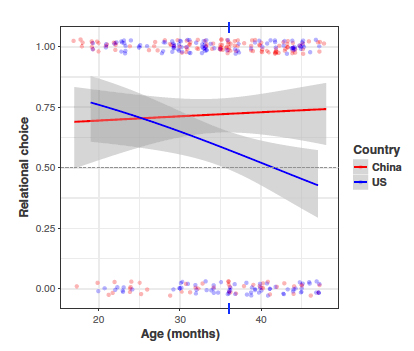When we say that objects are the same or similar, what do we really mean? It is a seemingly simple question that can unpack a lot of information. Understanding how small children perceive the world has long been a tool in our scientific exploration of how our brain and thinking develops. Children often characterize sameness based on objects superficial qualities; they look the same. Over time, in what is terms a “relational shift,” children can also identify similarity in one object’s relationship to another, they are the same even though the shape is different, one is always taller than another. This ability has been found in children 18 to 30 months of age; but oddly enough, this ability to identify sameness by relationship disappears at around age three only to return a year or so later. Why this pattern of success, loss, and recovery? The answer lies not in our genes, but in a powerful evolutionary force, our culture and language.
The researchers tested toddlers and children in these age groups for their ability to express sameness by an object’s surface qualities or by their relationship to other objects. They showed children object pairs that caused a song to play and asked them to choose which of two new pairs would play the song. The visual explains the  test far better than my words. The children in these experiments were clustered around, and within age 3, the window when identifying sameness seems to be lost; the cultural differentiator was that Chinese children were studied along with US children. In the first experiment, the choices of US children were correct roughly half the time, a result we could obtain simply by chance. Chinese children significantly surpassed them in the number of correct choices. Perhaps the Chinese children were not in that age window, stuck in that earlier phase or had catapulted ahead.
test far better than my words. The children in these experiments were clustered around, and within age 3, the window when identifying sameness seems to be lost; the cultural differentiator was that Chinese children were studied along with US children. In the first experiment, the choices of US children were correct roughly half the time, a result we could obtain simply by chance. Chinese children significantly surpassed them in the number of correct choices. Perhaps the Chinese children were not in that age window, stuck in that earlier phase or had catapulted ahead.
The researchers expanded the age group window to include younger children and found that the Chinese children didn’t have the dip we found with US children, they showed steady improvement in their incorporation of relational and surface similarity over the time.  In a final experiment, both groups of 3 year-olds were given ambiguous examples, where the pairs that played music could be either grouped by their object or relational sameness. The US children overwhelmingly chose based on surface sameness; the objects looked the same; the Chinese chose on relational similarity.
In a final experiment, both groups of 3 year-olds were given ambiguous examples, where the pairs that played music could be either grouped by their object or relational sameness. The US children overwhelmingly chose based on surface sameness; the objects looked the same; the Chinese chose on relational similarity.
What accounts for the difference?
Let’s save time; we don’t know. But one implicated cause is our language. US children have a “noun spurt” at about the age of 3; parents spend time teaching their children the names of objects; whereas it seems that there is similar “verb spurt” in Chinese children as their parents teach them more action or process words. It is intriguing to consider that many of the other characteristics we identify with our or Chinese culture follow along similar paths. Individuals are nouns; collective, collaborative societies are verbs. Medicine based on nouns allows for breaking a problem down into many small parts and assuming that the sum is equal to the elements; medicine based on verbs is holistic, the sum is far different than the parts.
The phrase “words have meaning” is often mentioned when words are hurtful or disappoint, but their power appears to be far greater, not just in reflecting, but in shaping our thinking. To steal from a meme, “are you a noun or a verb?” It seems that this applies to both individuals and societies.
Source: Context Shapes Early Diversity in Abstract Thought PNAS DOI: 10.1073/pnas1818365116/ -/DCSupplemental




